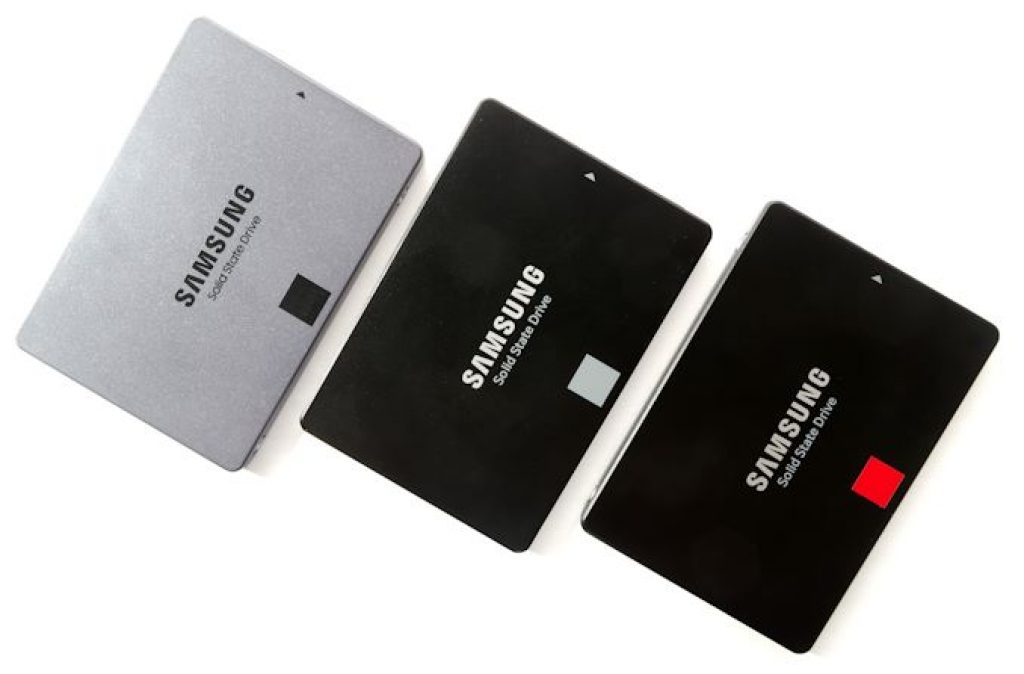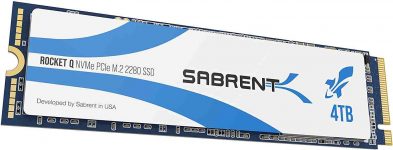For a quick and reliable option for storage, the most reliable SSD will keep your files big and secure. SSDs can be more expensive than traditional hard drives, which makes them the most economical option for a lot of people. Yet, SSDs are worth every cent you pay for SSDs.
It’s because SSDs are more durable and less susceptible to fail than HDDs because they do not have moving components. They also provide higher speeds for reading and writing that make them perfect for professionals in the creative field who require fast access to their data to facilitate a smoother workflow.
Selecting one specific drive from many high-capacity SSDs available on the market could be a challenge. We have today the most powerful 4TB SSDs you can purchase today. Below, you’ll find a wide range of different models, covering the majority of the market.
Best 4TB SSD 2023 Edition: Top 5 Market Picks
| Ranking | 4TB SSDs | Reviews |
| 1. | Sabrent Rocket Q 4TB | 5 out of 5 |
| 2. | Samsung 870 QVO 4TB | 4 out of 5 |
| 3. | Samsung 870 EVO 4TB | 4 out of 5 |
| 4. | Corsair MP400 4TB | 4 out of 5 |
| 5. | WD Blue 4TB | 4 out of 5 |
Top 4TB SSD 2023 Edition | Detailed Review
1. Sabrent Rocket Q 4TB
Sabrent Rocket Q 4TB
2. 3.15 x 0.86 x 0.11 inches
3. Form Factor M.2
Despite being a relatively small manufacturer, Sabrent’s excellent products & competitive pricing have made it the top choice for PC enthusiasts. The Rocket Q Sabrent 4TB SSD is yet another great product from Sabrent which is targeted towards those who are seeking for a large capacity SSD that’s also speedy. Sabrent Rocket Q 4TB SSD can be described as an NVMe-based drive that certainly meets the second requirement very well. It is able to be configured with capacities till 8TB with the same M.2 drive.
Also, it is provided in capacities of 500GB 1TB, 2TB, 8TB, and 4TB. That means there are plenty of choices to pick from which will meet the needs of different customers with specific needs. Its Rocket Q 4TB is equipped with continuous read speeds that range from to 3400 MB/s and the speed of sequential writing at about 3100 MB/s. It also comes with the DRAM cache and comes in M.2 attractive design, which reduces cables and is easy to set up.
The only downside for the 4TB RocketQ in addition to its cost it’s 3D NAND QLC design, just as Samsung QVO 870. It’s a challenge for the manufacturers to build the capacity of an 8TB SSD with the NAND TLC flash, while managing it within a budget. This is why very large capacity SSDs like this one utilise the NAND QLC format to maximise capacity.
Performance of Sabrent Rocket 4TB is outstanding due the 4TB NVMe-based interface. Thus, it is wise not to purchase this drive for your sole or primary storage device. QLC drives shouldn’t be used for installing OS, & should instead be used for high storage.
This model is equipped with the Phison E12S controller, which is the 8-ch quad-core 4-CE/ch configuration that has an internal DRAM cache. Its controller is impressive with the inclusion of the DRAM cache ensures that drive will not be prone to slowdowns or issues with endurance during extended usage. The cost of the Rocket 4TB is very expensive when compared with SATA SSDs. However, it’s very affordable in comparison to other capacity-intensive NVMe SSDs.
2. Samsung 870 QVO 4TB
Samsung 870 QVO 4TB
2. 3.94 x 2.76 x 0.27 inches
3. Form Factor 2.5-inch
Samsung is known in the world of storage due to its remarkable reliability and amazing efficiency of its SSDs. Its Samsung 870 QVO is Samsung’s SATA 4TB SSD option designed for the high capacity market. It is a 2.5-inch SATA SSD available in 2TB, 1TB, 4TB, 8TB etc.
It is powered by 3D QLC NAND Flash and it is capable of reaching the speed of sequential reading of 560 MB/s and write speeds up to 300 Mb/s. It’s simply one of the most powerful SSDs for SATA that you can purchase today. It is perfect for those who want to combine a high-quality, reliable SSD with an even smaller SSD to create an all-solid-state system. Samsung has announced the 870 QVO with capacities that range from 1TB all the way to 8 TB.
Two, four and eight TB versions are the most appropriate to use a massive storage SSD in a relatively modern gaming computer. The 870 QVO utilises the Samsung MKX controller, and comes with a Tri-core 8-ch and 8-CE/ch configuration. It also has a DRAM cache on the SSD. It is crucial to ensure long-term durability and long-term drive performance.
The only downside of this drive is that it makes use in the form of 3D QLC NAND Flash instead of TLC NAND which provides superior performance over time. But, this sacrifice is totally justified as QLC NAND allows the drive manufacturer to maximise performance of their drive, without increasing its cost too much.
The performance provided by this SSD is still impressive since the 870 QVO is capable of delivering the fastest sequential read speeds, which can be upwards of 560 MB/s. The fastest sequential write speeds are also listed as up to 300 MB/s. The QLC NAND does not hurt its performance much when it is used for smaller, lighter loads. However, you may encounter some slowdowns in comparison in the process. You also going to need best AM4 Motherboards get the best performance out of these top specs SSDs.
3. Samsung 870 EVO 4TB
Samsung 870 EVO 4TB
2. 3.94 x 2.76 x 0.27 inches
3. Form Factor 2.5-inch
The Samsung 870 EVO is focused on performance SATA SSD & makes use of the 3D NAND TLC Flash in place of QLC NAND found in the previous drives. The Samsung 870 EVO 4TB SSD external hard drive is much more durable and has better sustained endurance and performance & even beats NVMe drives for particular scenarios.
However, it is true that the NAND TLC can be more costly to make, and Samsung cannot provide the huge 4TB model of its 870 EVO that uses the TLC NAND. Samsung has launched its version 870 EVO coming in various capacities that range up to 250GB to upwards to 4TB.
It is a great choice and lets potential buyers pick the SSDs that they want. The majority of people with a tight budget can afford 250GB & 500GB choices and these SSDs are also fantastic Operating System drives, not having to spend a lot.
For those seeking the best storage drive, the 2TB & 4TB versions are present. These can be enough to store a huge library steam, & the Operating System files, too. The 870 EVO utilises a Samsung controller MJX, & comes with an 8-ch Tri-core & eight-CE/ch feature configuration.
This SSD includes the DRAM cache too and can reach speeds up to 550MB/s read & 520 MB/s write speeds in sequential mode that is the highest speed that can be achieved using this 6-Gbps SATA connection. In general, this 870 EVO is a SATA performance-focused SSD that provides excellent all-round performance because of the NAND TLC configuration.
4. Corsair MP400 4TB
Corsair have been around long ago and have earned an excellent reputation for their reliability and also for their outstanding customer service. The Corsair MP400 is a high-speed and high capacity NVMe alternative, similar to Sabrent Rocket Q 4 TB SSD. Sabrent Rocket Q, however it’s less expensive than the former. The MP400 also comes with a huge capacity of 8TB.
Corsair provides the MP400 with 1TB, 2TB 4TB, and 8TB capacities. They are sufficient for the majority of gamers. The 500GB capacity isn’t available from Corsair however it is a size that is more suitable as the operating system drives than an SSD drive for mass storage. The read speeds that sequentially occur on the MP400 can reach 3400 MB/s, with the sequential write speed being at 3000 MB/s.
The drive comes in the M.2 format, which helps clean away the cable mess and is simpler to install. It is worth taking the time to look through our choices of the best NVMe heatsinks for this model. Similar to Sabrent Rocket Q, however the Corsair MP400 comes with 3D NAND flash QLC to maximise its capacity, while keeping it reasonably affordable.
The drive is not experiencing any major performance issues, despite using the QLC NAND. This could be due to the superior NVMe speed that the drive is capable of generating. Three hundred and forty-four MB/s reading speed and 3000 MB/s write speeds are close to the maximum of what’s possible using NVMe protocol.
The Corsair MP400 has the same amazing Phison E12S controller used in it with the Sabrent Rocket Q. Its configuration is Quad-core, 8-chand 4-CE/ch that is identical to the Sabrent too. Both drives are alike in regards to internal components. The MP400 includes a DRAM cache which helps to improve the long-term endurance and efficiency of the drives.
We Believe you are a Gaming Enthusiast, You Might like Best Wifi Card for PC
5. WD Blue 4TB
The WD Blue range is the most performance-oriented lineup of 4TB SSDs from WD. The Blue SSDs utilize the TLC 3D NAND design, just as Samsung’s 870 EVO. It means that Western Digital Blue drives cannot even offer a 8TB model at a fair price and, therefore, WD has set the capacity at 4TB. In addition, it is true that Western Digital Blue is perhaps the most affordable high storage SSD currently available.
The Western Digital Blue comes in a range of capacities from 250GB to 4TB which means that the majority of users can pick the capacity that best suits their specific needs. The 500GB and 250GB drives offer great value as an OS drive to use on a gaming computer. Western Digital also offers 2TB & 4TB models that could be beneficial for people seeking a substantial amount of storage based on the affordability.
Western Digital has also made the Western Digital Blue drives available in their M.2 SATA form factor along with the 2.5 inch SATA. This makes it much easier to insert the drive directly onto the motherboard, removing cables, and also improves the overall look of the build. This WD Blue is comparatively cheaper than the 870 EVO and 4TB NVMe drives and can therefore be a viable alternative to these drives.
WD uses the 88SS1074 Marvell controller on the Western Digital Blue drives, which has 4ch Dual-Core and an 8-CH/ch feature configuration. It is also possible to use the Western Digital Blue drives that have the DRAM cache, which improves the endurance & enhances the performance over time. WD utilizes SanDisk’s TLC 3D NAND which has 64 layers allowing for more information to write into the NAND cells. Also, the configuration permits Western Digital Blue to deliver 560 MB/s read speed for continuous reads, & 530MB/s continuous write speeds, which effectively fills up all the SATA 6-Gbps connection.

Factors to Keep in Mind Before Buying best 4Tb SSD
PCI Express
The first application of the PCI Express interface for SSDs came in the shape of cards that were inserted into some PCIe slots in a motherboard for desktops. It is still possible to find cards for carriers that allow you to connect M.2 drives into PCIe slots. These days, however , the most well-known PCI Express SSDs are able to be mounted to an M.2 slot. However, like we mentioned above, be sure you have an M.2 slot that can support PCIe drives prior to making the purchase.
SATA
SATA isn’t as powerful in comparison to M.2 PCIe or PCIe card, but most laptops and desktops are able to use 2.5-inch SATA drives. Many using them for everyday tasks don’t even be able to tell the differences between modern SATA drives and one that is a speedier PCIe drive.
Compatible Interface
See if your computer supports a particular type of SSD by consulting the user manual or searching databases such as Crucial Memory Finder.
M.2 Drives
M.2 slots are becoming common in the latest desktop motherboards, and almost ubiquitous in modern laptops. Best M.2 SSDs are 2.5-inch drives stripped down to its core, and are very minimal in their design and installation. Consider first, the bus-type. M.2 drives are available with SATA buses and PCI Express bus flavours. They require an appropriate slot in order to function. Certain M.2 slots can support both buses within one slot. However, other drives can only support one bus to ensure that the SSD you purchase matches the bus type available on the slot you are using.
FAQs
Q1. Does NVMe perform quicker than SATA?
It is true that NVMe SSDs have the advantage of being significantly quicker than SSDs SATA because of their use of PCIe connections instead of the standard SATA connection. This lets them achieve significantly higher speeds, which is around 3400 MB/s for reads & writes as opposed to SATA SSDs which typically limit themselves to 555 MB/s for reads and writing continually. NVMe SSDs are a lot higher priced than SSDs that use SATA..
Q2. Should I purchase a DRAM-less SSD?
It is definitely worth looking into purchasing DRAM less SSD in case it fits your needs. DRAM-less SSDs aren’t as fast as traditional hard drives and the change should be visible. However, these SSDs have issues with long-term performance and reliability , which is why they’re ideal for other storage options. For your primary drive, you must look into the SSD that has the DRAM cache.
Q3. Should I purchase a higher storage NVMe SSDs?
The concept of buying an extremely powerful NVMe SSD is kind of a unique idea. NVMe SSDs typically have some kind of cache system, such as the Host Buffer Memory or DRAM. Therefore, their long-term performance is adequate in the majority of instances. Thus, every SSD comes with a limit of writing cycles that will end up running. With larger storage SSDs, the cycles will likely expire earlier because users are likely to upload large files, like games to the SSD frequently. The more affordable, higher storage SATA SSDs are better suited for this use.












